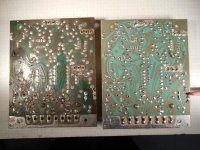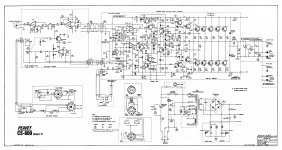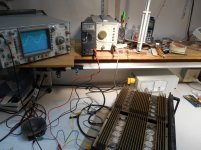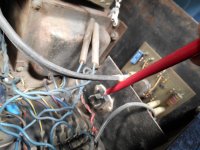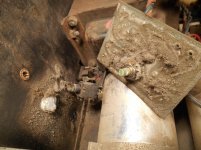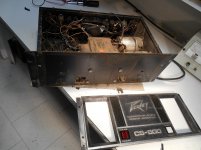Hi Indianajo;
I will use the jig from page 8 of this thread, to find a matched set of outputs. This was the test circuit used to select the outputs for my GPS 3500. If I can get this CS 800 to breath, I may spring for a complete set of new outputs ( ON semi's ).
At the moment I am facing the mangled driver board. I have a working driver board from a CS 400. I believe the board is identical. Both are marked "111778 DRIVER CS 800"
Are these boards interchange-able even though B+ and B- are different?
Board on the right is from the CS 400:
I will use the jig from page 8 of this thread, to find a matched set of outputs. This was the test circuit used to select the outputs for my GPS 3500. If I can get this CS 800 to breath, I may spring for a complete set of new outputs ( ON semi's ).
At the moment I am facing the mangled driver board. I have a working driver board from a CS 400. I believe the board is identical. Both are marked "111778 DRIVER CS 800"
Are these boards interchange-able even though B+ and B- are different?
Board on the right is from the CS 400:
Attachments
You're on your own unless Enzo contributes. I never heard of CS-400 until I saw a junk one for parts on E-bay last week. Enzo posted on a CS-800 thread yesterday over on PA amps.
CS-400 was more suitable for home use with lower rail voltage, I suppose. I might pick one up. I listen mostly at 1.5 v with +72 db peaks occasionally. The PV-1.3k I own rather scares me with +-85 rails: could launch a $120 speaker cone across the room if something goes wrong and it produces DC. My speakers cost 10 times what the blown amp cost. Speakers harder to find, too, low distortion SP2 speakers with original drivers. The DC protection circuits on the PV series were laughable, at least the 1.3K. Melted the triac off the output board without blowing the main breaker.
Don't know if these early nineties amps were as low distortion at low levels as the CS800s I own. Not specified at low wattages. 4558 as an op amp in the X suffix is nothing to write home about, and the early models are all transistor; who knows how much feedback and slew rate they have? Cs800s just started dropping out on one channel; hours of e-cap replacement and maybe contact cleaning are on the schedule. Right after a couple of organ projects clear the bench.
CS-400 was more suitable for home use with lower rail voltage, I suppose. I might pick one up. I listen mostly at 1.5 v with +72 db peaks occasionally. The PV-1.3k I own rather scares me with +-85 rails: could launch a $120 speaker cone across the room if something goes wrong and it produces DC. My speakers cost 10 times what the blown amp cost. Speakers harder to find, too, low distortion SP2 speakers with original drivers. The DC protection circuits on the PV series were laughable, at least the 1.3K. Melted the triac off the output board without blowing the main breaker.
Don't know if these early nineties amps were as low distortion at low levels as the CS800s I own. Not specified at low wattages. 4558 as an op amp in the X suffix is nothing to write home about, and the early models are all transistor; who knows how much feedback and slew rate they have? Cs800s just started dropping out on one channel; hours of e-cap replacement and maybe contact cleaning are on the schedule. Right after a couple of organ projects clear the bench.
Last edited:
I took the plunge!
I compared every component on the driver boards from the CS 400 and CS 800. Everything is identical except for R 16 and R 18. After making the 'conversion', I installed the board from the CS 400 in the CS 800 amp. The weak socket for the TO 3 driver was bent to make secure contact, and some 'iffy' solder joints on the power pcb were touched up. The dead channel is ALIVE!
Thanks to the info contributed to this thread, I ran the amp with only the 2 drivers and 2 outputs installed, into a 130 Ohm load. 58.3 Volts RMS, before clipping, not bad, I guess!.
I compared every component on the driver boards from the CS 400 and CS 800. Everything is identical except for R 16 and R 18. After making the 'conversion', I installed the board from the CS 400 in the CS 800 amp. The weak socket for the TO 3 driver was bent to make secure contact, and some 'iffy' solder joints on the power pcb were touched up. The dead channel is ALIVE!
Thanks to the info contributed to this thread, I ran the amp with only the 2 drivers and 2 outputs installed, into a 130 Ohm load. 58.3 Volts RMS, before clipping, not bad, I guess!.
Attachments
Hi Turk;
Thanks, I believe you are right, it must be the triac for the AC mains. I'm still not sure exactly what series this amp belongs to. It does not have switches on the volume pots, so I assumed it must be one of the first 'model A's.
I have 2 schematics for the 'C' version; one shows a double pole power switch, the other has the triac.
The triac is been removed from the circuit. Is there any advantage to reconnecting the triac, other than extending the life of the power switch?
And at the risk of redundancy; one more question: Can I order all new TO3 devices (I'm leaning towards ON semi MJ15024's) and use them as drivers AND outputs?
If so, why did Peavey use different drivers?
Thanks, I believe you are right, it must be the triac for the AC mains. I'm still not sure exactly what series this amp belongs to. It does not have switches on the volume pots, so I assumed it must be one of the first 'model A's.
I have 2 schematics for the 'C' version; one shows a double pole power switch, the other has the triac.
The triac is been removed from the circuit. Is there any advantage to reconnecting the triac, other than extending the life of the power switch?
And at the risk of redundancy; one more question: Can I order all new TO3 devices (I'm leaning towards ON semi MJ15024's) and use them as drivers AND outputs?
If so, why did Peavey use different drivers?
i recall something to the affect that the triac reduces in rush current (i recall replacing several double pole switch types due to arced contacts) i'm still looking for a lost pile of my old schematics (that's why i never got you the promised scans) as i have circuit notes written about some of the differences.
i also used to have a master list of "in house" part numbers and proper replacements.
i also used to have a master list of "in house" part numbers and proper replacements.
Thanks, turk and all;
A replacement list would be a great help at this point. I have two conflicting Series A schematics; one shows all 12 devices the same on the heat sink, the other has different Drivers.
If possible, I would like to find a common TO-3 that I could use in several of my amplifiers. I have used ON-Semi MJ21196G's in my Phase Linear 700B. According to Newark, the MJ15024 is a 'replacement'. My guess is the PL700B application is more demanding, but....the 15024G's are $6.19 ea and the 21196G's are $4.13 ea (at quantity 50)
Could I use the 21196G as a universal replacement, for the next Peavey or if (when) the next time the Phase Linear decides to have a bad day? Here are the ON Semi pdf's for both devices, Thanks for any thoughts.
A replacement list would be a great help at this point. I have two conflicting Series A schematics; one shows all 12 devices the same on the heat sink, the other has different Drivers.
If possible, I would like to find a common TO-3 that I could use in several of my amplifiers. I have used ON-Semi MJ21196G's in my Phase Linear 700B. According to Newark, the MJ15024 is a 'replacement'. My guess is the PL700B application is more demanding, but....the 15024G's are $6.19 ea and the 21196G's are $4.13 ea (at quantity 50)
Could I use the 21196G as a universal replacement, for the next Peavey or if (when) the next time the Phase Linear decides to have a bad day? Here are the ON Semi pdf's for both devices, Thanks for any thoughts.
Attachments
Last edited:
Congratulations on board swap success.
Yes, Peavey tended to back up the power switch with a triac so the actual copper contacts didn't take the huge turn on load. The location is where your picture showed. Not usually shown on schematics. Since my PV-1.3k dimmed the room lights at turn on, I put a 1.5 ohm 20 A capable NTC resistor in series with the AC line in- a technology that was not available that long ago.
If you're just doing a few output transistors, MJ15024/25 is a "match". If you're replacing them all, MJ21193/4 or MJ21195/6 is cheaper and allegedly has bigger soa and a smaller silicon die. Enzo told me this was okay for all at once. How rugged do you want? Does the bigger die result in less blow ups? My advice, ditch the 1/4 phone jacks and go with dual banana jacks or Nutrix; you may not blow as many output transistors as the previous owner. Setting up in the dark on stage and getting the 1/4 phone plug all the way in was a serious challenge for bar band roadies (unpaid usually).
As far as different transistors for drivers, the late amps like the CS800s have a magnificant slew rate spec - 20 v/microsec if I remember right (brochure is on the other computer). Cs800s also use a MJ15020/21 TO3 driver instead of a MJ15024/25 like the early models. The 15020/21 has much higher Ft than the 15024/25 but is not as rugged at high currents. Slew rate was IMHO not spec'd on the old CS800 no suffix.
If you want your tinkly bells and top octave piano (high frequency sources) to be accurate at high power, use the faster drivers IMHO. Probably would pep up slew rate even on an old design. As I'm using an old (1998) synthesizer for my sound source in concerts with my PV-1.3k (potentially) I haven't bothered to buy the fast parts for drivers yet. My audience is actually so small (50 max) a real wood piano is doing the job fine.
Yes, Peavey tended to back up the power switch with a triac so the actual copper contacts didn't take the huge turn on load. The location is where your picture showed. Not usually shown on schematics. Since my PV-1.3k dimmed the room lights at turn on, I put a 1.5 ohm 20 A capable NTC resistor in series with the AC line in- a technology that was not available that long ago.
If you're just doing a few output transistors, MJ15024/25 is a "match". If you're replacing them all, MJ21193/4 or MJ21195/6 is cheaper and allegedly has bigger soa and a smaller silicon die. Enzo told me this was okay for all at once. How rugged do you want? Does the bigger die result in less blow ups? My advice, ditch the 1/4 phone jacks and go with dual banana jacks or Nutrix; you may not blow as many output transistors as the previous owner. Setting up in the dark on stage and getting the 1/4 phone plug all the way in was a serious challenge for bar band roadies (unpaid usually).
As far as different transistors for drivers, the late amps like the CS800s have a magnificant slew rate spec - 20 v/microsec if I remember right (brochure is on the other computer). Cs800s also use a MJ15020/21 TO3 driver instead of a MJ15024/25 like the early models. The 15020/21 has much higher Ft than the 15024/25 but is not as rugged at high currents. Slew rate was IMHO not spec'd on the old CS800 no suffix.
If you want your tinkly bells and top octave piano (high frequency sources) to be accurate at high power, use the faster drivers IMHO. Probably would pep up slew rate even on an old design. As I'm using an old (1998) synthesizer for my sound source in concerts with my PV-1.3k (potentially) I haven't bothered to buy the fast parts for drivers yet. My audience is actually so small (50 max) a real wood piano is doing the job fine.
Last edited:
Learning all the time!
I see now that a higher Ft could be the reason for different drivers. I have it from a reliable source (thanks turk), that the approved sub for the 6387 driver is an MJ-13330. So far, I have not found a source for this, has anyone ordered directly from China?
Specs indicate an Ft of min 5 MHz to 40 MHz for the MJ13330 and a min 4 MHz / no maximum spec'ed for the MJ15024. In a round about way one can 'equivalent' my way into matching the driver to the MJ15024, but now I have the 'slew rate' bug.
Hope this is not against forum policy; but any experience with iscsemi.cn?
Thanks again, all
I see now that a higher Ft could be the reason for different drivers. I have it from a reliable source (thanks turk), that the approved sub for the 6387 driver is an MJ-13330. So far, I have not found a source for this, has anyone ordered directly from China?
Specs indicate an Ft of min 5 MHz to 40 MHz for the MJ13330 and a min 4 MHz / no maximum spec'ed for the MJ15024. In a round about way one can 'equivalent' my way into matching the driver to the MJ15024, but now I have the 'slew rate' bug.
Hope this is not against forum policy; but any experience with iscsemi.cn?
Thanks again, all
I just checked mj15020/21 at newark digikey & mouser, no stock. I should have bought some a couple of years ago when they did have them. 20 mhz min Ft in a TO3 case.
Crossing borders to buy transistors is something usually best left up to the pros at distributors. We can't test Ft at incoming inspection to verify what we've got is not some generic 2n3055/mj2955 copy.
Same with crossing borders with old transformers; substitution is not a problem but it costs too much. Thanks for the thought. There was a $28 Pv-4c on ebay usa last time I looked, $35 freight. Less total than a new 63v transformer without case fan or heat sinks.
Crossing borders to buy transistors is something usually best left up to the pros at distributors. We can't test Ft at incoming inspection to verify what we've got is not some generic 2n3055/mj2955 copy.
Same with crossing borders with old transformers; substitution is not a problem but it costs too much. Thanks for the thought. There was a $28 Pv-4c on ebay usa last time I looked, $35 freight. Less total than a new 63v transformer without case fan or heat sinks.
ISC is one of those gray-area suppliers that make "copies" of obsolete devices, which may or may not be up to snuff. I've seen innards of MT200 Sanken copies from them that lack the proper heat spreader, but have a normal size die. Fake? No, because it's labeled ISC. Will it take 200 watts? Don't know - have to buy some and find out. Will an MJ13330 copy be any better? Don't know. But if you put a genuine On 21194 in there it won't blow up.
Is a higher ft driver needed? Probably not to set the slew rate - it's set by the compensation cap. Less THD20k? Possibly. Less cross conduction current if you feed it a 20k square wave - definitely. But that's not what you use a CS800 for, nor will that happen running party music 12dB into clip. Most of it will be bass and midrange. If you run a compression driver hard enough to hurt your amp I pity the poor driver.
What you can do if you are intent on higher fT drivers is keep on the lookout for gently -used (or NOS) D555's or some old Sanken LAPT's in a TO-3. (If you ever run across such, you always buy a pair or two just in case you may need them. ) Or even some modern ones in a TO3P, and fit it the way you would if you have to use a TO220 to replace an unobtainium TO66.
Is a higher ft driver needed? Probably not to set the slew rate - it's set by the compensation cap. Less THD20k? Possibly. Less cross conduction current if you feed it a 20k square wave - definitely. But that's not what you use a CS800 for, nor will that happen running party music 12dB into clip. Most of it will be bass and midrange. If you run a compression driver hard enough to hurt your amp I pity the poor driver.
What you can do if you are intent on higher fT drivers is keep on the lookout for gently -used (or NOS) D555's or some old Sanken LAPT's in a TO-3. (If you ever run across such, you always buy a pair or two just in case you may need them. ) Or even some modern ones in a TO3P, and fit it the way you would if you have to use a TO220 to replace an unobtainium TO66.
People that bought the Peavey CS400/800 new were driving party rooms at 400+ watts, but e-bay/craigslist are raining blown up ones for $25-100. My CS800s sounds better on the SP2 speaker @ 1/4 W than any sound system I've heard in this flyover town that wasn't made of hardwood, felt, wire, pewter and leather (pianos and pipe organs). So for us bargain hunters, a repaired late Peavey with $100 in parts can provide stellar sound, IMHO even though I'm not using the high power capability much. By contrast, a crawl through e-bay recently revealed no blown NAD amps, no blown Parasound (J Curl right?), one blown Mark Levinson bid > $400.Is a higher ft driver needed? Probably not to set the slew rate - it's set by the compensation cap. Less THD20k? Possibly. Less cross conduction current if you feed it a 20k square wave - definitely. But that's not what you use a CS800 for, nor will that happen running party music 12dB into clip. Most of it will be bass and midrange. If you run a compression driver hard enough to hurt your amp I pity the poor driver.
If I listen at 1.5 v in my living room, 1/4 W on 8 ohm speakers, then 70 db higher for classical music peaks is 70/20 =3.5 anti log base 10 or 3500 times the power , or 750 W. So a 400 w/ch amp on classical music in my living room is not totally stupid, even though I'll see 70 db peaks about .0001 % of the time. BTW those SP2 speakers will take it, up to 52 V.
As far as availability of fast driver transistors, setting Newark USA selector grid to Ft>10 mhz, Vce>100, P>150W, got the following stock:
ON Semi MJL4281AG, MJL4302AG
Multicomp BUY69A * &, 2N6341 * &
Allegro Sanken 2SC3263 2SD2390 2SC3264
NTE 53 *,2348, 2N5239 *,2328,307,58, 283 *, 387 *
where * means TO3 package
The cheapest TO3 were BUY69A at $1.89 but they were only 10 mhz. The most bullet proof would probably be the On semi TO3P parts.
To see the PNP parts you set the voltage maximum to less than -150 v instead of the minimum >150 v
The TO66 trick alluded to means you take a TO3P or TO264 plastic case part, put the square insulator under it, cut the heat tab corners off to clear the heat sink fins, and bend the leads to fit in a TO3 spot.
Happy shopping in Canada.
Last edited:
Thanks all;
I have seen newer style plastic packages installed in TO-3 sockets, but if for no other reason, it just doesn't 'look good'!
What I have learned so far;
The driver transistors have higher hFE and higher fT than the outputs. There was not a proper driver anywhere in this amp, MJ-15024's will work in all 24 sockets, but I would like to optimize this amp, rather than just repair it.
I would like to find a TO-3 packaged driver, but I will heed the advice above and not gamble on 'grey area' suppliers.
The MJ-21194 has higher hFE than the 15024, but same fT. The search will continue---wife is telling me to get to work.
Here is another upgrade I have found here at diyaudio, sorry for giving proper credit;
"Two nasty sins against Hi-Fi are easily rectified for less than $10. First there is a non polarized electrolytic cap in the signal path, second the input stage is an MC1741.....which is basically the same as an LM741. An OPA134 and a metalized poly film cap are nice improvements one can make on the cheap."
Here is an update; I can't believe that one channel still pumped out 330 Watts into 8 Ohms! A day after taking this apart, I still had a craving for a smoke!
I have seen newer style plastic packages installed in TO-3 sockets, but if for no other reason, it just doesn't 'look good'!
What I have learned so far;
The driver transistors have higher hFE and higher fT than the outputs. There was not a proper driver anywhere in this amp, MJ-15024's will work in all 24 sockets, but I would like to optimize this amp, rather than just repair it.
I would like to find a TO-3 packaged driver, but I will heed the advice above and not gamble on 'grey area' suppliers.
The MJ-21194 has higher hFE than the 15024, but same fT. The search will continue---wife is telling me to get to work.
Here is another upgrade I have found here at diyaudio, sorry for giving proper credit;
"Two nasty sins against Hi-Fi are easily rectified for less than $10. First there is a non polarized electrolytic cap in the signal path, second the input stage is an MC1741.....which is basically the same as an LM741. An OPA134 and a metalized poly film cap are nice improvements one can make on the cheap."
Here is an update; I can't believe that one channel still pumped out 330 Watts into 8 Ohms! A day after taking this apart, I still had a craving for a smoke!
Attachments
That amp post 136 looks like it has been to sea, on a coal barge tug. I've worked on test equipiment that sunk in the Mediterranean, but there wasn't that much dirt after they hosed it off. Rode home in a DI water bath, cleaned, dried out, repaired, used as a shop mule.
Roger upgrading from 741's to OPa anything, they are primitive. 4558 is allegedly a dual 741, I got those out of my disco mixer 4 years ago. Much less hiss with ST33078, which are cheap but newer.
Searching for fast driver transistors, you can do the same type search on farnell.com Canada site- farnell are owners of newark USA after all.
Of the parts above, MJL4281/4303 are npn/pnp pairs, 1.2 A 1 sec soa @ 80 v, fast, pretty **** tough, TO3p, $5.50. Allegro Sanken 2SC3263 has 1.8 A DC soa @ 80v, TO3P, $.97, definitely worth a try at that price. The other two Sankens are MT220 package, too wide to fit.
The BUY69a is a 1000 v driver, no soa listed, too weird for amplifier service. 2N6340/1 is fast enough, 140 v Vce is a little light and DC soa is 100 ma @ 80v, waay too flimsy for a Peavey.
NTE's are pricey except for 2n5039 which is 90 Vceo on Boca's datasheet, too light for a CS800. NTE says theirs are 150 v parts, they better be at $4.73 ea. Boca 2n5039 has soa of 400 ma @ 80 v.
So at $1 each and the same TO3p package as MJL4281/4302, I'd try the Sanken. Don't forget the heat sink pads, and the farnell kits come with the plastic ferruls to keep the leads from shorting against the heat sink. However bad it looks. Keep the cover on.
Again, canadian stock may be totally different.
As far as hot-rodding slew rate on old iron, take what wg-ski said about the compensation capacitor to heart. Maybe you can upgrade to the cs800s spec no sweat, maybe the old board layout will oscillate if you do that. Costs $1 for the cap, worth a try. Faster slew rate drivers may really help high freq IM distortion like he alluded to, one of my pet peaves about electronic reproduction systems. I've got the ears left to hear it, and be annoyed by hissing buzzing high frequencies.
Roger upgrading from 741's to OPa anything, they are primitive. 4558 is allegedly a dual 741, I got those out of my disco mixer 4 years ago. Much less hiss with ST33078, which are cheap but newer.
Searching for fast driver transistors, you can do the same type search on farnell.com Canada site- farnell are owners of newark USA after all.
Of the parts above, MJL4281/4303 are npn/pnp pairs, 1.2 A 1 sec soa @ 80 v, fast, pretty **** tough, TO3p, $5.50. Allegro Sanken 2SC3263 has 1.8 A DC soa @ 80v, TO3P, $.97, definitely worth a try at that price. The other two Sankens are MT220 package, too wide to fit.
The BUY69a is a 1000 v driver, no soa listed, too weird for amplifier service. 2N6340/1 is fast enough, 140 v Vce is a little light and DC soa is 100 ma @ 80v, waay too flimsy for a Peavey.
NTE's are pricey except for 2n5039 which is 90 Vceo on Boca's datasheet, too light for a CS800. NTE says theirs are 150 v parts, they better be at $4.73 ea. Boca 2n5039 has soa of 400 ma @ 80 v.
So at $1 each and the same TO3p package as MJL4281/4302, I'd try the Sanken. Don't forget the heat sink pads, and the farnell kits come with the plastic ferruls to keep the leads from shorting against the heat sink. However bad it looks. Keep the cover on.
Again, canadian stock may be totally different.
As far as hot-rodding slew rate on old iron, take what wg-ski said about the compensation capacitor to heart. Maybe you can upgrade to the cs800s spec no sweat, maybe the old board layout will oscillate if you do that. Costs $1 for the cap, worth a try. Faster slew rate drivers may really help high freq IM distortion like he alluded to, one of my pet peaves about electronic reproduction systems. I've got the ears left to hear it, and be annoyed by hissing buzzing high frequencies.
Last edited:
Hi Folks;
About to drag the CS-800 outside to blow out some of the nicotine and coal dust! In the mean time, I am still struggling with selecting the best replacement driver and output devices.
Not to re-hash an age-old question, I have done some searching; Having replaced outputs in Phase Linears, I found a thread on diyaudio;
" diyaudio.com/forums/solid-state/157798-phase-linear-700b-power-transistors-upgrade-2.html" Entry 13 reads (thank you releone71);"
Entry #13:
"I talked with several techs in other forums in my country and read the service manuals with all the bulletins and the last mentioned substitute was the couple MJ21193/21194. Therefore, it seems natural to go now with the MJ21195/21196 which are better in the SOA performance (3A as opposed to the 2.5A of the oldest)"
From this, it seems the 21196 would be an all-encompassing substitute. From the spec sheets, the distortion is 'characterized, where as the MJ13330 (not available anyway) and MJ15024, are not.
Question: What concerns are there if using the MJ21196 as driver and output?
I am heavily biased (ha ha) towards this device, as it seems to be the most economical, ($4.13 ea in quantity 50) and a quantity purchase would allow a future CS800 or PL700 rebuild.
Here are the specs for all the usual suspects: thanks again all for tolerating my beating of the dead horse.
About to drag the CS-800 outside to blow out some of the nicotine and coal dust! In the mean time, I am still struggling with selecting the best replacement driver and output devices.
Not to re-hash an age-old question, I have done some searching; Having replaced outputs in Phase Linears, I found a thread on diyaudio;
" diyaudio.com/forums/solid-state/157798-phase-linear-700b-power-transistors-upgrade-2.html" Entry 13 reads (thank you releone71);"
Entry #13:
"I talked with several techs in other forums in my country and read the service manuals with all the bulletins and the last mentioned substitute was the couple MJ21193/21194. Therefore, it seems natural to go now with the MJ21195/21196 which are better in the SOA performance (3A as opposed to the 2.5A of the oldest)"
From this, it seems the 21196 would be an all-encompassing substitute. From the spec sheets, the distortion is 'characterized, where as the MJ13330 (not available anyway) and MJ15024, are not.
Question: What concerns are there if using the MJ21196 as driver and output?
I am heavily biased (ha ha) towards this device, as it seems to be the most economical, ($4.13 ea in quantity 50) and a quantity purchase would allow a future CS800 or PL700 rebuild.
Here are the specs for all the usual suspects: thanks again all for tolerating my beating of the dead horse.
Attachments
My answer to question post 139 answered post 131. Enzo is not watching this I guess, he has been on parts forum recently. I'm using MJ21193/4 instead of MJ15024/5 in the PV-1.3k because newark had them that day, they were a $ cheaper and had better soa than MJ15024/25. MJ21195/6 strike me as being equivalent. Actual full power long duration tests not done on the newer parts. I don't like "music" run against amp clipping limit all the time anyway.
There may be some advantage to using higher Ft parts for drivers than the MJ15024/25, as Peavey did on the CS800x and CS800s. What revision is this amp? If it has the 39 pf capacitors b to c on the driver transistors like revision b, no reason to use faster Ft drivers IMHO. I don't have schematics on any revisions between b and x. I'm a piano/bell/celeste fan and derive great pleasure from no HF intermodulation distortion in some amps, like the CS800s. Guitar/bass/vocal (only) fans, or techno/house fans will never notice the difference because those sources don't have much HF over 7000 hz. I repaired an organ amp today, that has 110 pf b to c on the VAS (voltage amplifier stage) because 1980 Allen organs don't have any high frequencies either.
There may be some advantage to using higher Ft parts for drivers than the MJ15024/25, as Peavey did on the CS800x and CS800s. What revision is this amp? If it has the 39 pf capacitors b to c on the driver transistors like revision b, no reason to use faster Ft drivers IMHO. I don't have schematics on any revisions between b and x. I'm a piano/bell/celeste fan and derive great pleasure from no HF intermodulation distortion in some amps, like the CS800s. Guitar/bass/vocal (only) fans, or techno/house fans will never notice the difference because those sources don't have much HF over 7000 hz. I repaired an organ amp today, that has 110 pf b to c on the VAS (voltage amplifier stage) because 1980 Allen organs don't have any high frequencies either.
Last edited:
- Status
- This old topic is closed. If you want to reopen this topic, contact a moderator using the "Report Post" button.
- Home
- Live Sound
- Instruments and Amps
- Pet Peeve Peavey (GPS 3500)
